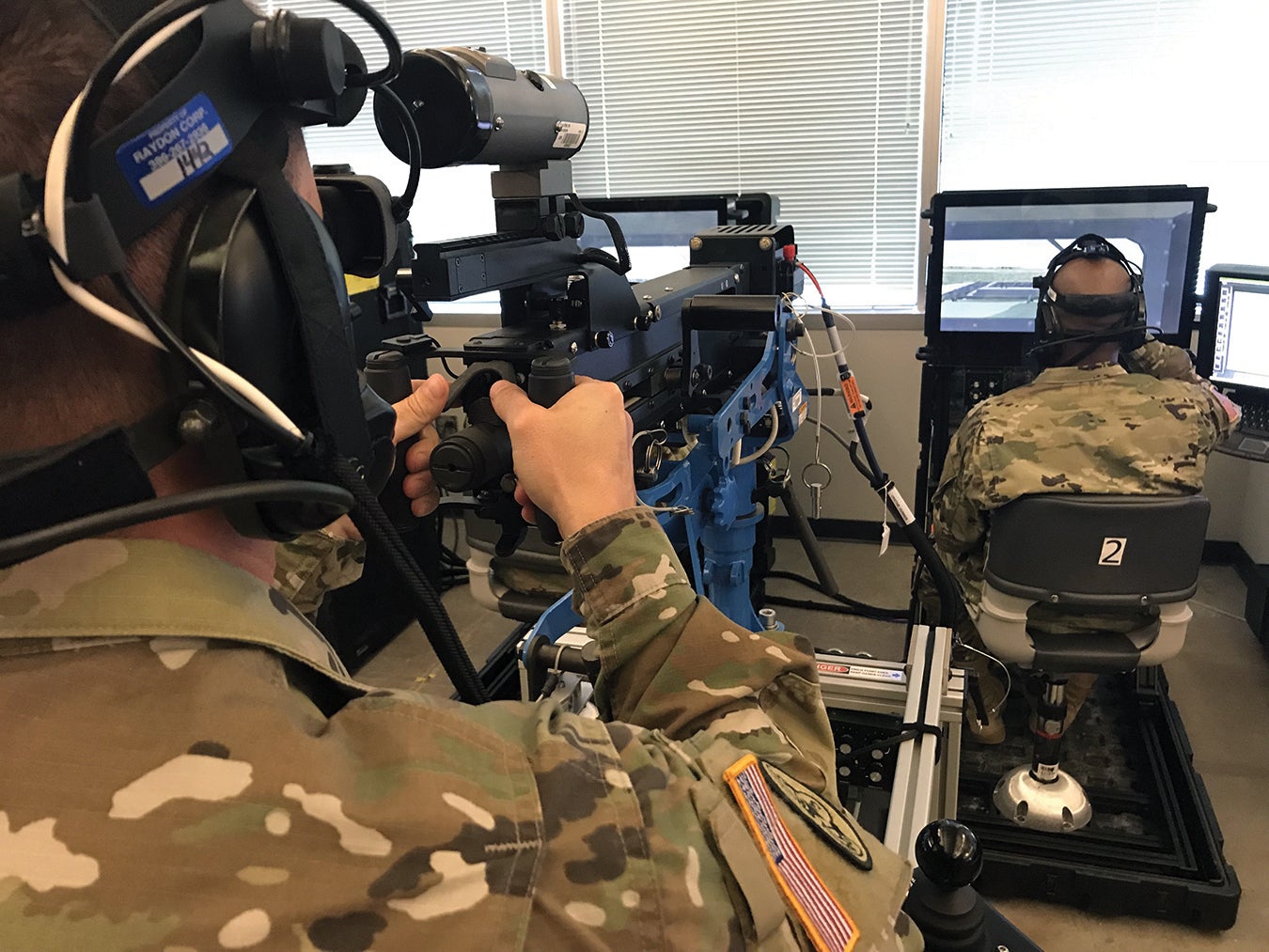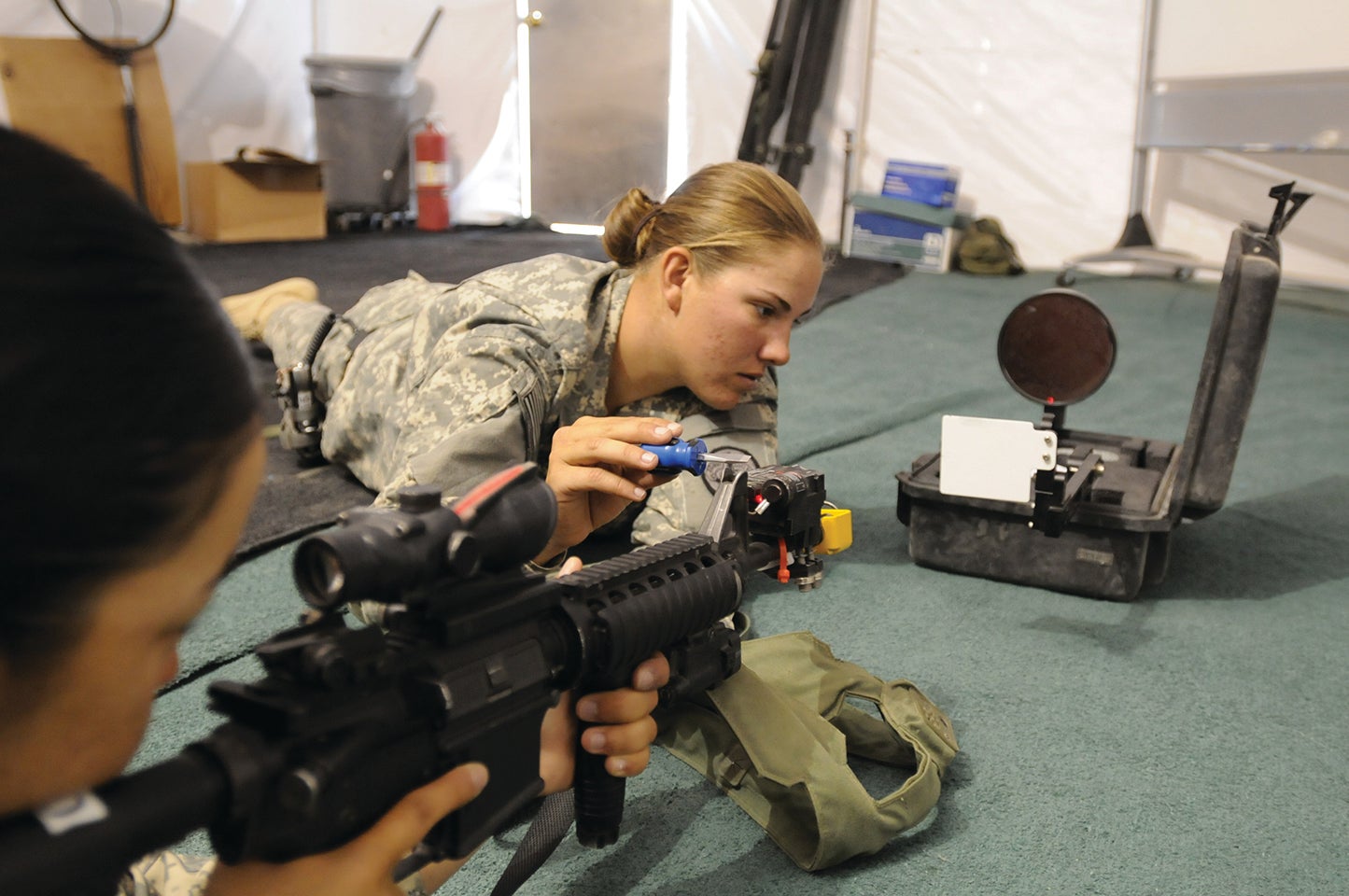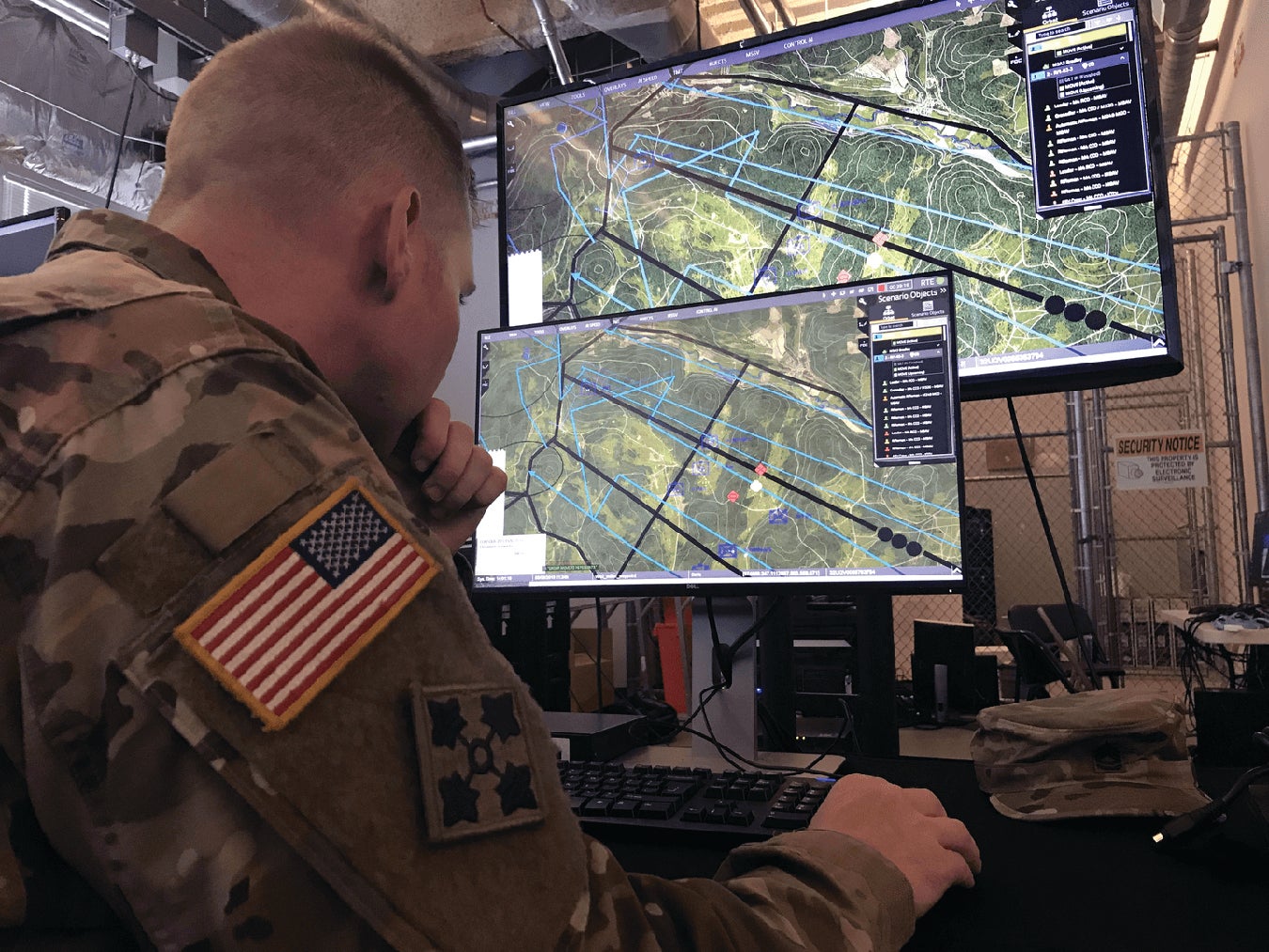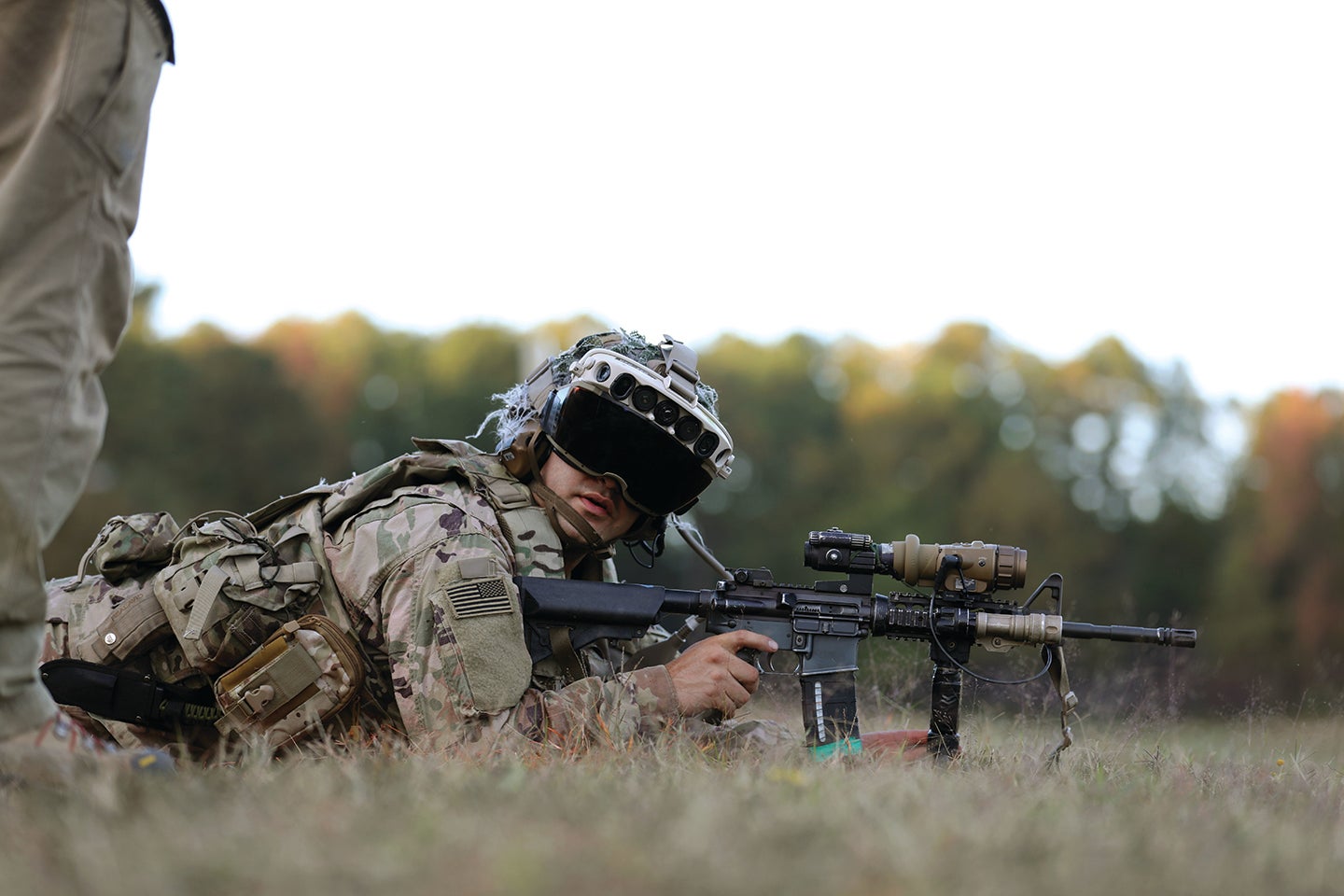The Synthetic Training Environment
The Synthetic Training Environment

From wherever they may be located—home station, armories, institutions or deployed locations—we want our Soldiers to enter into a Synthetic Training Environment that immerses them in diverse complex operational environments that replicate where they will fight; whom they will fight with; on the terrain they will fight on.
Major General Maria Gervais1
Years of budgetary instability and high operational tempo against low-tech opponents have impeded DoD efforts to modernize for high-end conflict against great-power competitors. DoD leadership expects ground close- combat formations to play a critical role in any peer-on-peer fight.2 These formations—most vulnerable to enemy fire—comprise four percent of U.S. military personnel, yet they suffer 90 percent of all casualties. Despite their vulnerability, they receive less than two percent of the defense budget.3
The Synthetic Training Environment (STE) is the U.S. Army’s program to revolutionize the Army’s entire training paradigm. STE is especially critical for improving Soldier lethality and survivability by enhancing the efficiency and realism of live training, building terrain familiarity, providing mission repetition and simulating combat.4 By combining live, virtual, constructive and gaming training environments, STE will provide accessible, interoperable training, which simulates real-world terrain in its full complexity. Its advanced three-dimensional mapping software provides operational utility as well.
Background
As described in the 2018 National Defense Strategy (NDS), great-power competitors—Russia and China—seek to counter U.S. military strengths through anti-access/area denial (A2/AD). They challenge international norms and threaten the security of the United States and that of its allies and partners. Iran and North Korea pose persistent, significant threats, and violent extremist organizations remain dangerous. Protecting ground close-combat units and increasing their lethality is essential to achieving the missions set forth in the 2018 NDS.5
War is ultimately decided by close quarters dominance. The U.S. Army’s operating concept, Multi-Domain Operations (MDO), defines a central role for close combat units in great-power conflict. Highly-trained infantry will disperse and maneuver to survive enemy precision firepower and to dominate enemy ground forces. They will operate a system of sensors to detect, communicate and converge fires across domains. Their ability to operate in highly-contested environments is critical to enabling the joint force to compete, penetrate, disintegrate, exploit and shape terrain protected by enemy A2/AD.6 This demands tough, realistic, iterative, accessible and dynamic synthetic training.7

Current Close-Combat Training
Close-combat ground units have increasingly complicated missions. They must be ready to operate in complex environments—such as in cities, with contested communications—while facing increasingly formidable enemy firepower. Congruent with the DoD’s Close Combat Lethality Task Force (CCLTF), improving close-combat capability relative to peer-rivals is one of the Army’s key warfighting challenges.8 To prepare, the Army extended one-station unit training from 14 to 22 weeks9 and is turning to virtual training to improve training efficiency and realism.
Current virtual training has several shortcomings:
- it is not realistic or dynamic;
- it does not simulate human interaction;
- it is too sterile;
- it does not optimally collect data;
- it does not train cross-domain convergence;
- it is not interoperable;
- it is difficult to access; and
- it does not integrate with live and constructive training.10
Simply put, training programs that are not interoperable and cannot train convergence across all five warfighting domains are obsolete. The Army’s Integrated Training Environment (ITE) simulators use proprietary systems that are not interoperable, making it difficult to upgrade or customize training. Current systems cannot train multi-domain convergence or bring in enablers, e.g., logistics, medical, engineering and transportation teams.11
The Army currently uses the decades-old Multiple Integrated Laser Engagement System (MILES) for force-on-force training. This is expensive, requires time-consuming setup, lacks realism and can ingrain poor habits. For example, it allows Soldiers to take cover behind soft obstacles that block MILES from registering a hit but which, in reality, would not be able to stop a bullet.12 Furthermore, real ammunition travels along trajectories. MILES laser targeting travels in a straight line.
Current simulations operate on closed, restrictive networks, are facilities-based, require high personnel overhead and feature 57 inconsistently compatible terrain formats.13 Manual terrain reconstructions are expensive and time-consuming.14 Setting up a live, virtual, constructive exercise currently takes about 120–180 days to plan and can only be done in 12 locations—10 in the continental United States and two overseas. This limits the availability of training and its responsiveness to a commander’s needs.15
STE: The Future of Army Training
STE is the Army’s top training modernization initiative.16 Army senior leadership expects to have initial operating capability by 2021 and full operational capability by 2023.17
|
Current Virtual Training
|
Future Training (STE)
|
Close-combat training must present real dilemmas, must require Soldiers to adapt to unforeseen circumstances and must allow cross-domain convergence training. STE will complement live and constructive training to replicate any battlefield and enable the repetition—including the “25 bloodless battles” before experiencing combat—deemed essential by DoD leadership.18 It will use Soldiers’ actual equipment and will meld live and virtual training environments into a single platform with multiple delivery systems to increase repetitions in a variety of scenarios without being tethered to a specific location. It will focus on high-intensity combat in contested environments, including megacities.19
Interoperability
STE replaces a hodgepodge of outdated, non-interoperable training simulators. A subject matter expert from the STE cross-functional team (CFT) compared the vision for interoperability to the development of railroads; non-interoperable platforms gave way to interoperable ones by necessity.20 Unlike the ITE, which patches together proprietary systems, STE will allow joint, interagency and multi-national interoperability.21 STE’s One World Terrain (OWT) software will be compatible with combined joint all-domain command and control (C2) architecture.
International partners are developing technology designed to be compatible with OWT, showing the technology’s promise. For instance, Israel’s CT-MENTOR mapping system for navigation and targeting in GPS-denied environments is able to utilize open architecture designed to receive mapping materials from other systems, including OWT.22

Software
STE is software-focused. Its non-proprietary system can be easily updated without locking the Army into limiting contracts with specific providers, enabling its synthetic training to keep up with the changing battlefield.23 STE can be accessed easily and at the point of need, giving Soldiers unprecedented access to realistic virtual training, while open architecture enables interoperability across echelons, domains, forces and with partners.24
Artificial Intelligence (AI) will be built into STE architecture.25 It will sort and present data—including the battlefield, timing, precision, lethality and biometrics—like a mapping application on a smartphone. It will continuously self-upgrade through machine learning—using a predictive analysis of the data that it collects.26
Squad Immersive Virtual Trainer (SiVT)
|
|
|
|
|
One World Terrain (OWT)
|
|
|
|
|
Training Simulation Software (TSS)
|
|
|
|
|
Facilities
STE untethers the unit’s training from “brick and mortar” facilities by using cloud computing with the ability to stream. STE will be accessible at “point of need” through a web-based app that uses the Army’s existing operational and tactical networks. It will be deliverable to a Soldier’s mobile device, workspace, combat platform or any common operating environment, e.g., a motor-pool or a deployed location.31
Equipment
STE will be integrated into the next generation of optics and weapons, allowing Soldiers to train, rehearse and fight with the same equipment. Goggle sensors will feature IVAS, with a heads-up display that utilizes augmented reality to identify potential targets, find ranges and enable synthetic training. IVAS can link to drones and provide remote viewing of weapon sights from various shooters, including thermal and night vision cameras, enabling low-risk, rapid target acquisition. Sensors track heart and respiration rates and can also detect concussions.32 Training will feel real, invoking fear and fatigue.33 It will also track friendly forces, reducing friendly fire. Prototypes have been put to uses as versatile as checking temperatures to combat the spread of COVID-19.34 STE-compatible optics will also enhance intelligence, reconnaissance and surveillance (ISR), collecting data and mapping terrain. Signature programs include: next-generation squad weapons, enhanced night vision goggles and adaptive Soldier architecture.
Training Realism
In current simulated training, the virtual enemy has preprogramed actions and responses. Real-world opponents are unpredictable. AI-enabled simulated opponents can learn, adapt and present unique challenges and increasingly difficult scenarios. This will force Soldiers to adapt in real time, instead of learning how to defeat a game’s preprogrammed scenarios.35
STE must accurately simulate ranges, trajectories, targets and effects. For example, virtual rounds must hit where they would on a live range and must also deliver the same effect; likewise, simulated protective gear, equipment and terrain must accurately register the effects of being hit. Wounds should be registered as accurately as possible for data generation purposes. Haptic suits are another option that can improve simulated experiences; when Soldiers wear them during exercises, they vibrate at varying intensities to add touch to visual and auditory sensory experience.36 STE will be used in between dry and live-fire training with the goal of demonstrably improving the latter.37
Training Impact
Psychological fidelity—the degree to which the simulation prompts cognitive, emotional and behavioral responses relevant to performance—matters more than physical fidelity for designing effective simulation-based training.38 Training should elicit a similar need for attention, perception of workload and reactions or emotions that occur when operating in a live environment. User interface is more important than any other metric, including realistic visual depiction of physical objects and terrain. STE aims to increase lethality, not to create the most sophisticated video game. If virtual training does not translate to battlefield proficiency, it is, at best, a waste of time. At worst, it reinforces bad practices.
Operational Utility
STE demonstrated its operational utility in Project Convergence 2020, the first in a series of exercises to prepare the Army to operate with joint—and eventually coalitional—partners on a multi-domain battlefield. In Project Convergence 2021, the STE will be part of “mission threads,” including linking to C2 platforms and leveraging ISR data to provide Soldiers and commanders with three-dimensional terrain representations in real-time. The STE CFT plans to work with the intelligence community on other possible uses for the technology as well.39

Challenges
Rendering Data
Terrain is STE’s “Achilles’ heel.”40 STE needs to render the data that it collects into usable simulations, e.g., turning aerial video of walls and buildings into simulations that accurately respond to being hit by specific munitions at specific ranges. The Army is exploring using AI to accelerate this process. The Army will continue to face difficulty mapping subterranean networks and dense urban terrain, especially where access is limited.
Augmented Reality
Augmented reality training is optimal because it is physical. It requires Soldiers to maneuver in full gear, on difficult terrain, while using virtual avatars and “clutter” to replicate real-world complexity.41 This poses a significant challenge because simulated terrain does not match the physical space on which it is overlaid. For example, how would the STE provide augmented reality training for an urban operation in a skyscraper to units that are training inside a constructive facility with limited building height?
Bandwidth and Latency
Insufficient network bandwidth, high latency and cybersecurity pose important but not insurmountable challenges. STE requires an estimated 50 megabits per second, per Soldier, necessitating an increase in current bandwidth. Bandwidth consumption cannot over-tax existing Army networks, especially in operating environments where bandwidth is scarce. STE addresses this through cloud storage. Edge computing is an essential complement to the cloud. It allows data processing where the devices and users are located, reducing latency and bandwidth usage.42
Cybersecurity
STE will generate data on how Soldiers and units fight, what gaps exist and how weapon systems work. A security breach would provide an adversary with a treasure trove of data. Interoperability with international partners increases these risks. STE will need built-in cybersecurity, but this has its drawbacks. Robust cybersecurity strategies—such as the Zero Trust—embed firewalls throughout the system’s architecture to stop data breaches. However, this also blocks the automatic flow of data within the system, impeding its ability to self-upgrade through machine learning.43
Cognitive Limitations
Researchers at the United States Military Academy’s Modern War Institute conducted an experiment to test how simulated training impacts live performance. When presented with virtual-reality goggles and preloaded imagery, many tech-savvy cadets were too cognitively overloaded to effectively use the simulations. More research is needed to optimize simulated training for improved battlefield performance.44
The Way Forward
OWT requires massive data collection, processing, storage, distribution and 3D content development. STE CFT leadership sees great commercial industry advancements toward addressing these requirements.45
Setting up STE requires a capabilities-driven acquisition process, close partnerships with industry and academia and budgetary stability. Army leadership wants requirements determination to be on a 12-month timescale and to be fully informed by Soldier feedback.46
In 2019, the STE CFT moved to the University of Central Florida—the epicenter for modeling, simulation and training for the defense industry. This location enables it to work closely with the U.S. Army Program Executive Officer for Simulation, Training and Instrumentation as well as with academia and industry leaders. The STE CFT plans to leverage the multi-billion-dollar gaming industry to develop accurate simulations of real-world terrain.47
The Army should encourage working with international partners. For example, OWT development might benefit from working with the Israel Defense Forces unit 9900 on real-time mapping. This unit uses aircraft and satellites to provide operators with real-time data, including virtual three-dimensional mapping that allows ground units to virtually go floor-by-floor and room-by-room to find their targets.48
The STE will develop incrementally, informed by user feedback from prototype field-testing.49 Demands to industry should be flexible so that prototypes are driven by desired capabilities and feedback from operators, but structured enough so that industry has clear parameters. Working closely with operators will also help the Army to create training programs that are optimized to develop battlefield skills.50
Conclusion
As the future battlefield becomes more complex, ground close-combat units will have an increasingly critical, intricate and dangerous mission. Technology already exists to revolutionize training, supporting the CCLTF vision to increase close-combat overmatch. STE enhances ISR, data collection and data analysis. It provides training, operational capabilities and the accessibility needed for sufficient repetition. Unlike the ITE it replaces, STE is interoperable, easy to access and it trains Soldiers with the equipment that they will use in combat. It allows realistic and dynamic MDO training, including cross-domain, cross-force and multiple-partner convergence. It will especially improve urban operations training by simulating clutter, crowd dynamics, logistics, long-range fires, cyber and electronic warfare. Bandwidth, latency, cyber security and the potential for cognitive overload pose surmountable challenges. With stable budgets and efficient coordination with industry, academia and international partners, the STE will provide critical training for the MDO-capable Army of 2028 and the MDO-proficient Army of 2035.
★ ★ ★ ★
Jeremiah Rozman is a National Security Analyst at the Association of the United States Army. He served as an infantryman in the Israel Defense Forces and has a PhD in Foreign Affairs from the University of Virginia.
1 Synthetic Training Environment Cross Functional Team, “Synthetic Training Environment,” Stand-To!, 26 March 2018.
2 Close combat is defined as “ground combat executed by dismounted infantry squad-sized formations carried out within line of sight of the enemy and characterized by extreme violence.” DoD, Directive-type Memorandum (DTM)-18-001 – Establishment of the Close Combat Lethality Task Force (CCLTF), 16 March 2018, https://fas.org/irp/doddir/dod/dtm-18-001.pdf.
3 Daniel S. Roper, “Regaining Tactical Overmatch: The Close Combat Lethality Task Force,” Association of the United States Army, Spotlight 18-2, 2 April 2018.
4 Jen Judson, “25 Bloodless Battles: Synthetic Training Will Help Prepare for Current and Future Operations,” Defense News, 5 September 2018.
5 DoD, Summary of 2018 National Defense Strategy of The United States of America: Sharpening the American Military’s Competitive Edge, 19 January 2018.
6 Department of the Army, U.S. Army Training and Doctrine Command (TRADOC) Pamphlet 525-3-1, The U.S. Army in MDO 2028 (Washington, DC; U.S. Government Printing Office 2018).
7 Mark A. Milley and Mark T. Esper, The Army Vision, June 2018, https://www.army.mil/e2/downloads/rv7/vision/the_army_vision.pdf.
8 Army Warfighting Challenges “Army Capabilities Integration Center,” 2019, http://arcic-sem.azurewebsites.us/initiatives/armywarfightingchallenges.
9 Thomas Bradding, “22-Week Infantry OSUT Set to Increase Lethality, With More Career Fields to Follow,” Army News Service, 5 November 2019.
10 Maria R. Gervais, “The Synthetic Training Environment,” TRADOC MadSci 2018, Georgia Tech Research Institute, 26 June 2018.
11 Ryan Pickrell, “This Smart Tech Can Tell Instantly Whether or not a US Army Soldier is Ready for War,” Business Insider, 12 October 2018.
12 Staff, “Ready Trainee One: U.S. Army Builds Synthetic Battlefield to Blend With Live Training,” Raytheon Intelligence & Space, 3 June 2018.
13 Sydney J. Freedberg Jr., “Special Ops Using Army’s Prototype 3D Maps on Missions: Gervais,” Breaking Defense, 13 October 2019.
14 Kyle McCullough, “Prototypes,” Institute for Creative Technologies One World Terrain OWT,” University of Southern California Institute for Creative Technologies, November 2018, http://ict.usc.edu/prototypes/one-world-terrain-owt/.
15 Gervais, “The Synthetic Training Environment.”
16 Joint Intermediate Force Capabilities U.S. Department of Defense Non-Lethal Weapons Program, Army pursuing improved realism in live and virtual training, 3 December 2019, https://jnlwp.defense.gov/Press-Room/In-The-News/Article/2052043/army-pursuing-improved-realism-in-live-and-virtual-training/.
17 Connie Lee, “I/ITSEC NEWS: Extended CR Threatens Timeline for Army’s New Training System,” National Defense Magazine, 4 December 2019.
18 Gina Cavallaro, “A New Way to Train,” ARMY 69, no. 9 (September 2019), 18–20.
19 Maria R. Gervais, “The Synthetic Training Environment Revolutionizes Sustainment Training,” Army News Service, 23 August 2018.
20 Damon Durall, “STE and the Digital Revolution,” Infantry 107, no. 3 (July–September 2018), 37–38.
21 “Synthetic Training Environment (STE),” white paper, Combined Arms Center, Training (CAC-T), 2018, https://usacac.army.mil/sites/default/files/documents/cact/STE_White_Paper.pdf.
22 Seth J. Frantzman, “New Rafael System Helps Vehicles Navigate in GPS-Denied Environments,” C4ISRnet, 16 October 2020.
23 STE software includes: Live Virtual Constructive-Integrated Architecture (LCV-IA) Games for Training, Synthetic Environment Core, Close-Combat Tactical Trainer, Aviation Combined Arms Tactical Trainer and Joint Land Component Constructive Training Capability. For more information, see “Live, Virtual, Constructive-Integrating,” PEO:STRI, https://www.peostri.army.mil/live-virtual-constructive-integrating-architecture-lvc-ia.
24 Gervais, “The Synthetic Training Environment Revolutionizes Sustainment Training.”
25 “Synthetic Training Environment (STE),” white paper.
26 Durall, “STE and the Digital Revolution.”
27 Jon Harper, “Army Accelerating Synthetic Training Environment Programs,” National Defense Magazine, 21 November 2018.
28 Pickrell, “This Smart Tech Can Tell Instantly Whether or not a US Army Soldier is Ready for War.”
29 Office of the Undersecretary of Defense (Comptroller)/Chief Financial Officer, Defense Budget Overview, Fiscal Year 2020, March 2019, 9-3.
30 “Synthetic Training Environment (STE),” white paper.
31 Beverly M. Cooper, “Training at the Point of Need Boosts Soldier Lethality,” Signal, 22 August 2019.
32 Joshua Brustein, “Microsoft Wins $480 Million Army Battlefield Contract,” Bloomberg, 28 November 2018.
33 Gervais, “The Synthetic Training Environment.”
34 Jaspreet Gill, “Army using IVAS prototype in COVID-19 efforts,” Inside Defense, 27 April 2020.
35 Major General Maria R. Gervais, “The Synthetic Training Environment,” TRADOC MadSci 2018, Georgia Tech Research Institute, GA, 26 June 2018.
36 Haptics is the use of vibration patterns to convey information to a user, e.g., simulated recoil or impact. To learn more about how the Army envisions using haptics for training, see “STTC Awards ECS BAA Contract to Evaluate the Use of Haptics Technologies in Training Simulation Environments,” Engineering & Computer Simulations.
37 Staff, “Investment in Synthetic Training Environments,” Israel Homeland Security iHLS, 4 January 2019, https://i-hls.com/archives/88009.
38 Susan G. Straus et al., Collective Simulation-Based Training in the U.S. Army (Santa Monica, CA: RAND, 2019).
39 Mandy Mayfield, “AUSA News: Army Sees Expanded Role for 3D Training Tool,” National Defense Magazine, 15 October 2020.
40 Jacqueline M. Hames and Margaret C. Roth, “Virtual Battlefield Represents Future of Training” Army News Service, 15 January 2019.
41 Gervais, “The Synthetic Training Environment.”
42 Phil Goldstein, “Edge Computing: Air Force and FEMA Take Advantage of the Intelligent Edge,” FedTech Magazine, 28 February 2019.
43 For more information about Zero Trust cyber security, see Gus Hunt, “How zero trust solves the ‘weakest link’ problem,” FCW: The Business of Federal Technology, 24 August 2020.
44 John Spencer and John Amble, “The Simulations Road to Real War,” Association of the United States Army, 22 August 2018.
45 Jon Harper, “Army Accelerating Synthetic Training Environment Programs,” National Defense Magazine, 21 November 2018.
46 Daniel S. Roper, “Seizing the High Ground: United States Army Futures Command,” Association of the United States Army, Spotlight 18-4, 1 October 2018.
47 James Rogers, “Notre Dame Cathedral fire: How a Video Game and 3D Laser Scans Could Help the Reconstruction Effort,” Fox News, 16 April 2019.
48 Anna Ahronheim, “Meet the Unit Behind the Scenes of the IDF’s Precision Warfare,” Jerusalem Post, 2 July 2020.
49 “Synthetic Training Environment (STE),” white paper.
50 John Spencer and John Amble, “The Simulations Road to Real War.”

